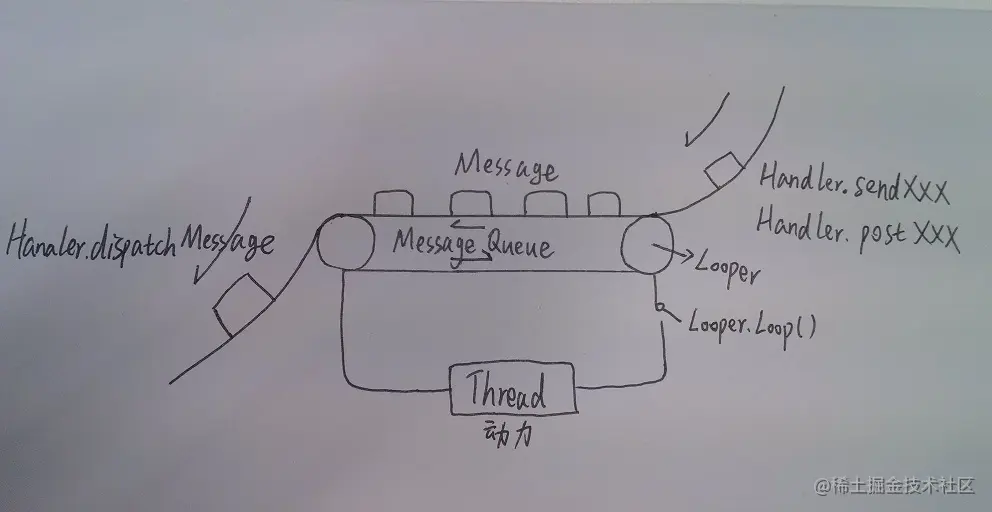一、概述
Handler是Android中处理异步消息的机制。Looper、Handler、MessageQueue、Message概括来说就是:Looper负责的就是创建一个MessageQueue,然后进入一个无限循环体不断从该MessageQueue中读取消息Message,然后回调相应的消息处理函数,而消息的创建者就是一个或多个Handler,执行完成一个消息后则继续循环。
二、MessageQueue详解
消息队列MessageQueue就是存放消息的队列。那队列中存储的消息是什么呢?假设我们在UI界面上单击了某个按钮,而此时程序又恰好收到了某个广播事件,那我们如何处理这两件事呢? 因为一个线程在某一时刻只能处理一件事情,不能同时处理多件事情,所以我们不能同时处理按钮的单击事件和广播事件,我们只能挨个对其进行处理,只要挨个处理就要有处理的先后顺序。为此Android把UI界面上单击按钮的事件封装成了一个Message,将其放入到MessageQueue里面去,即将单击按钮事件的Message入栈到消息队列中,然后再将广播事件的封装成以Message,也将其入栈到消息队列中。也就是说一个Message对象表示的是线程需要处理的一件事情,消息队列就是一堆需要处理的Message的池。线程Thread会依次取出消息队列中的消息,依次对其进行处理。
MessageQueue中有两个比较重要的方法,一个是enqueueMessage方法,一个是next方法。enqueueMessage方法用于将一个Message放入到消息队列MessageQueue中,next方法是从消息队列MessageQueue中阻塞式地取出一个Message。
三、Looper详解
消息队列MessageQueue只是存储Message的地方,真正让消息队列循环起来的是Looper,这就好比消息队列MessageQueue是个水车,那么Looper就是让水车转动起来的河水,如果没有河水,那么水车就是个静止的摆设,没有任何用处,Looper让MessageQueue动了起来。
Looper是用来使线程中的消息循环起来的。默认情况下当我们创建一个新的线程的时候,这个线程里面是没有消息队列MessageQueue的。为了能够让线程能够绑定一个消息队列,我们需要借助于Looper:首先我们要调用Looper的prepare方法,然后调用Looper的loop方法。
(一)prepare()方法
public static final void prepare() {
if (sThreadLocal.get() != null) {
throw new RuntimeException("Only one Looper may be created per thread");
}
sThreadLocal.set(new Looper(true));sThreadLocal是一个ThreadLocal对象,可以在一个线程中存储变量。可以看到,将一个Looper的实例放入了ThreadLocal,并且先判断了sThreadLocal.get是否为null,否则抛出异常。这也就说明了Looper.prepare()方法不能被调用两次,同时也保证了一个线程中只有一个Looper实例。
(二)构造函数
上面的代码执行了Looper的构造函数,我们看一下其代码:
private Looper(boolean quitAllowed) {
mQueue = new MessageQueue(quitAllowed);
mRun = true;
mThread = Thread.currentThread();
}在构造函数中,创建了一个消息队列MessageQueue,并将其赋值给其成员字段mQueue,这样Looper也就与MessageQueue通过成员字段mQueue进行了关联。
(三)loop()方法
public static void loop() {
final Looper me = myLooper();
if (me == null) {
throw new RuntimeException("No Looper; Looper.prepare() wasn't called on this thread.");
}
final MessageQueue queue = me.mQueue;
// Make sure the identity of this thread is that of the local process,
// and keep track of what that identity token actually is.
Binder.clearCallingIdentity();
final long ident = Binder.clearCallingIdentity();
for (;;) {
Message msg = queue.next(); // might block
if (msg == null) {
// No message indicates that the message queue is quitting.
return;
}
// This must be in a local variable, in case a UI event sets the logger
Printer logging = me.mLogging;
if (logging != null) {
logging.println(">>>>> Dispatching to " + msg.target + " " +
msg.callback + ": " + msg.what);
}
msg.target.dispatchMessage(msg);
if (logging != null) {
logging.println("<<<<< Finished to " + msg.target + " " + msg.callback);
}
// Make sure that during the course of dispatching the
// identity of the thread wasn't corrupted.
final long newIdent = Binder.clearCallingIdentity();
if (ident != newIdent) {
Log.wtf(TAG, "Thread identity changed from 0x"
+ Long.toHexString(ident) + " to 0x"
+ Long.toHexString(newIdent) + " while dispatching to "
+ msg.target.getClass().getName() + " "
+ msg.callback + " what=" + msg.what);
}
msg.recycle();
}
}上面有几行代码是关键代码:
1. final Looper me = myLooper();
myLooper()方法直接返回了sThreadLocal存储的Looper实例,如果me为null则抛出异常,也就是说looper方法必须在prepare方法之后运行。
final Looper me = myLooper();
if (me == null) {
throw new RuntimeException("No Looper; Looper.prepare()
wasn't called on this thread.");
}public static Looper myLooper() {
return sThreadLocal.get();
}2. final MessageQueue queue = me.mQueue;
拿到该looper实例中的消息队列mQueue。变量me是通过静态方法myLooper()获得的当前线程所绑定的Looper,me.mQueue是当前线程所关联的消息队列。
3. for (;;)
进入了循环。我们发现for循环没有设置循环终止的条件,所以这个for循环是个无限循环。
4. Message msg = queue.next(); // might block
取出一条消息,如果没有消息则阻塞。我们通过消息队列MessageQueue的next方法从消息队列中取出一条消息,如果此时消息队列中有Message,那么next方法会立即返回该Message,如果此时消息队列中没有Message,那么next方法就会阻塞式地等待获取Message。
5. msg.target.dispatchMessage(msg);
msg的target属性是Handler,该代码的意思是让Message所关联的Handler通过dispatchMessage方法让Handler处理该Message。
6. msg.recycle();
释放消息占据的资源。
(四)Looper主要作用
1.与当前线程绑定,保证一个线程只会有一个Looper实例,同时一个Looper实例也只有一个MessageQueue。
2.loop()方法,不断从MessageQueue中去取消息,交给消息Message的target属性,即Handler的dispatchMessage去处理。
二、Handler详解
(一)构造函数
使用Handler之前,我们都是初始化一个实例,比如用于更新UI线程,我们会在声明的时候直接初始化,或者在onCreate中初始化Handler实例。所以我们首先看Handler的构造方法,看其如何与MessageQueue联系上的,它在子线程中发送的消息(一般发送消息都在非UI线程)怎么发送到MessageQueue中的。
public Handler() {
this(null, false);
}
public Handler(Callback callback, boolean async) {
if (FIND_POTENTIAL_LEAKS) {
final Class extends Handler> klass = getClass();
if ((klass.isAnonymousClass() || klass.isMemberClass() || klass.isLocalClass()) &&
(klass.getModifiers() & Modifier.STATIC) == 0) {
Log.w(TAG, "The following Handler class should be static or leaks might occur: " +
klass.getCanonicalName());
}
}
mLooper = Looper.myLooper();
if (mLooper == null) {
throw new RuntimeException(
"Can't create handler inside thread that has not called Looper.prepare()");
}
mQueue = mLooper.mQueue;
mCallback = callback;
mAsynchronous = async;
}上面有几行代码是关键代码:
1. public Handler(Callback callback, boolean async)
Handler.Callback是用来处理Message的一种手段,如果没有传递该参数,那么就应该重写Handler的handleMessage方法,也就是说为了使得Handler能够处理Message,我们有两种办法:
(1)向Hanlder的构造函数传入一个Handler.Callback对象,并实现Handler.Callback的handleMessage方法。
(2)无需向Hanlder的构造函数传入Handler.Callback对象,但是需要重写Handler本身的handleMessage方法。
//在主线程中创建mHandler,所以自动绑定主线程
private Handler mHandler = new Handler(){
@Override
public void handleMessage(@NonNull Message msg) {
switch (msg.what){
case 1:
System.out.println("handleMessage thread id " + Thread.currentThread().getId());
System.out.println("msg.arg1:" + msg.arg1);
System.out.println("msg.arg2:" + msg.arg2);
System.out.println("msg.obj:" + msg.obj.toString());
System.out.println("msg.setDate:" + msg.getData().get("QQ"));
textview.setText("success");
break;
}
}
};
private Handler mHandler2 = new Handler(new Handler.Callback() {
@Override
public boolean handleMessage(@NonNull Message msg) {
switch (msg.what){
case 1:
System.out.println("handleMessage thread id " + Thread.currentThread().getId());
System.out.println("msg.arg1:" + msg.arg1);
System.out.println("msg.arg2:" + msg.arg2);
System.out.println("msg.obj:" + msg.obj.toString());
System.out.println("msg.setDate:" + msg.getData().get("QQ"));
textview.setText("success");
break;
}
return false;
}
});也就是说无论哪种方式,我们都得通过某种方式实现handleMessage方法,这点与Java中对Thread的设计有异曲同工之处。
在Java中,如果我们想使用多线程,有两种办法:
(1)向Thread的构造函数传入一个Runnable对象,并实现Runnable的run方法。
(2)无需向Thread的构造函数传入Runnable对象,但是要重写Thread本身的run方法。
2. mLooper = Looper.myLooper();
首先通过Looper.myLooper()获取了当前线程保存的Looper实例。
3.mQueue = mLooper.mQueue;
然后再获取该Looper实例中保存的消息队列MessageQueue,这样就保证了Handler的实例与Looper实例中MessageQueue关联上了。
(二)sendMessage()方法
public final boolean sendMessage(Message msg)
{
return sendMessageDelayed(msg, 0);
} public final boolean sendEmptyMessageDelayed(int what, long delayMillis) {
Message msg = Message.obtain();
msg.what = what;
return sendMessageDelayed(msg, delayMillis);
} public final boolean sendMessageDelayed(Message msg, long delayMillis)
{
if (delayMillis < 0) {
delayMillis = 0;
}
return sendMessageAtTime(msg, SystemClock.uptimeMillis() + delayMillis);
} public boolean sendMessageAtTime(Message msg, long uptimeMillis) {
MessageQueue queue = mQueue;
if (queue == null) {
RuntimeException e = new RuntimeException(
this + " sendMessageAtTime() called with no mQueue");
Log.w("Looper", e.getMessage(), e);
return false;
}
return enqueueMessage(queue, msg, uptimeMillis);
}辗转反则最后调用了sendMessageAtTime,在此方法内部有直接获取MessageQueue,然后调用了enqueueMessage方法,我们再来看看此方法:
private boolean enqueueMessage(MessageQueue queue, Message msg, long uptimeMillis) {
msg.target = this;
if (mAsynchronous) {
msg.setAsynchronous(true);
}
return queue.enqueueMessage(msg, uptimeMillis);
}上面有几行代码是关键代码:
1. msg.target = this;
该代码将Message的target绑定为当前的Handler。
2. queue.enqueueMessage;
变量queue表示的是Handler所绑定的消息队列MessageQueue,通过调用queue.enqueueMessage(msg, uptimeMillis)我们将Message放入到消息队列中。
现在已经很清楚了Looper会调用prepare()和loop()方法,在当前执行的线程中保存一个Looper实例,这个实例会保存一个MessageQueue对象,然后当前线程进入一个无限循环中去,不断从MessageQueue中读取Handler发来的消息。然后再回调创建该消息的Handler中的dispathMessage方法。Handler的dispatchMessage的源码如下:
public void dispatchMessage(Message msg) {
if (msg.callback != null) {
handleCallback(msg);
} else {
if (mCallback != null) {
if (mCallback.handleMessage(msg)) {
return;
}
}
handleMessage(msg);
}上面有几行代码是关键代码:
1. if (msg.callback != null) { handleCallback(msg); }
首先会判断msg.callback存不存在,msg.callback是Runnable类型,如果msg.callback存在,那么说明该Message是通过执行Handler的postXXX系列方法将Message放入到消息队列中的,这种情况下会执行handleCallback(msg), handleCallback源码如下:
private static void handleCallback(Message message) {
message.callback.run();
}这样我们我们就清楚地看到我们执行了msg.callback的run方法,也就是执行了postXXX所传递的Runnable对象的run方法。
2. else { if (mCallback != null) { if (mCallback.handleMessage(msg)) { return; } }
如果我们不是通过postXXX系列方法将Message放入到消息队列中的,那么msg.callback就是null,代码继续往下执行,接着我们会判断Handler的成员字段mCallback存不存在。mCallback是Hanlder.Callback类型的,我们在上面的Handler构造函数提到过,在Handler的构造函数中我们可以传递Hanlder.Callback类型的对象,该对象需要实现handleMessage方法,如果我们在构造函数中传递了该Callback对象,那么我们就会让Callback的handleMessage方法来处理Message。
3.handleMessage(msg);
如果我们在构造函数中没有传入Callback类型的对象,那么mCallback就为null,那么我们会调用Handler自身的hanldeMessage方法,该方法默认是个空方法,我们需要自己是重写实现该方法。
综上,我们可以看到Handler提供了三种途径处理Message,而且处理有前后优先级之分:首先尝试让postXXX中传递的Runnable执行,其次尝试让Handler构造函数中传入的Callback的handleMessage方法处理,最后才是让Handler自身的handleMessage方法处理Message。
让我们看一下handleMessage(msg)
/**
* Subclasses must implement this to receive messages.
*/
public void handleMessage(Message msg) {
}可以看到这是一个空方法,为什么呢,因为消息的最终回调是由我们控制的,我们在创建handler的时候都是复写handleMessage方法,然后根据msg.what进行消息处理。
private Handler mHandler = new Handler(){
public void handleMessage(android.os.Message msg){
switch (msg.what){
case value:
break;
default:
break;
}
};
};到此,sendMessage方式流程已经解释完毕,接下来看下post方式。
(三)post()方法
mHandler.post(new Runnable()
{
@Override
public void run()
{
Log.e("TAG", Thread.currentThread().getName());
mTxt.setText("yoxi");
}
});然后run方法中可以写更新UI的代码,其实这个Runnable并没有创建什么线程,而是发送了一条消息,下面看源码:
public final boolean post(Runnable r){
return sendMessageDelayed(getPostMessage(r), 0);
} private static Message getPostMessage(Runnable r) {
Message m = Message.obtain();
m.callback = r;
return m;
}可以看到,在getPostMessage中,得到了一个Message对象,然后将我们创建的Runable对象作为callback属性,赋值给了此message。 注:产生一个Message对象,可以new也可以使用Message.obtain()方法;两者都可以,但是更建议使用obtain方法,因为Message内部维护了一个Message池用于Message的复用,避免使用new重新分配内存。
public final boolean sendMessageDelayed(Message msg, long delayMillis)
{
if (delayMillis < 0) {
delayMillis = 0;
}
return sendMessageAtTime(msg, SystemClock.uptimeMillis() + delayMillis);
} public boolean sendMessageAtTime(Message msg, long uptimeMillis) {
MessageQueue queue = mQueue;
if (queue == null) {
RuntimeException e = new RuntimeException(
this + " sendMessageAtTime() called with no mQueue");
Log.w("Looper", e.getMessage(), e);
return false;
}
return enqueueMessage(queue, msg, uptimeMillis);
}最终和handler.sendMessage一样,调用了sendMessageAtTime,然后调用了enqueueMessage方法,给msg.target赋值为handler,最终加入MessagQueue。
public void dispatchMessage(Message msg) {
if (msg.callback != null) {
handleCallback(msg);
} else {
if (mCallback != null) {
if (mCallback.handleMessage(msg)) {
return;
}
}
handleMessage(msg);
}
}可以看到,这里msg的callback和target都有值,那么会执行msg.callback != null的判断,则执行handleCallback回调,也就是我们的Runnable对象。
三、总结
到此,这个流程已经解释完毕,让我们首先总结一下:
- 首先Looper.prepare()在本线程中保存一个Looper实例,然后该实例中保存一个MessageQueue对象;因为Looper.prepare()在一个线程中只能调用一次,所以MessageQueue在一个线程中只会存在一个。
- 在Lopper构造函数中,创建了一个消息队列MessageQueue,并将其赋值给其成员字段mQueue,这样Looper也就与MessageQueue通过成员字段mQueue进行了关联。
- Looper.loop()会让当前线程进入一个无限循环,不端从MessageQueue的实例中读取消息,然后回调msg.target.dispatchMessage(msg)方法。
- Handler的构造方法,会首先得到当前线程中保存的Looper实例,进而与Looper实例中的MessageQueue想关联。
- Handler的sendMessage方法,会给msg的target赋值为handler自身,然后加入MessageQueue中。
- 在构造Handler实例时,我们会重写handleMessage方法,也就是msg.target.dispatchMessage(msg)最终调用的方法。
四、一图胜千言
我们在本文讨论了Thread、MessageQueue、Looper以及Hanlder的之间的关系,我们可以通过如下一张传送带的图来更形象的理解他们之间的关系。

在现实生活的生产生活中,存在着各种各样的传送带,传送带上面洒满了各种货物,传送带在发动机滚轮的带动下一直在向前滚动,不断有新的货物放置在传送带的一端,货物在传送带的带动下送到另一端进行收集处理。
我们可以把传送带上的货物看做是一个个的Message,而承载这些货物的传送带就是装载Message的消息队列MessageQueue。传送带是靠发送机滚轮带动起来转动的,我们可以把发送机滚轮看做是Looper,而发动机的转动是需要电源的,我们可以把电源看做是线程Thread,所有的消息循环的一切操作都是基于某个线程的。一切准备就绪,我们只需要按下电源开关发动机就会转动起来,这个开关就是Looper的loop方法,当我们按下开关的时候,我们就相当于执行了Looper的loop方法,此时Looper就会驱动着消息队列循环起来。
那Hanlder在传送带模型中相当于什么呢?我们可以将Handler看做是放入货物以及取走货物的管道:货物从一端顺着管道划入传送带,货物又从另一端顺着管道划出传送带。我们在传送带的一端放入货物的操作就相当于我们调用了Handler的sendMessageXXX、sendEmptyMessageXXX或postXXX方法,这就把Message对象放入到了消息队列MessageQueue中了。当货物从传送带的另一端顺着管道划出时,我们就相当于调用了Hanlder的dispatchMessage方法,最终执行handleMessage方法,在该方法中我们完成对Message的处理。
文章来源于互联网:Android Handler机制:Looper、Handler、MessageQueue、Message的关系
1、本站所有资源均从互联网上收集整理而来,仅供学习交流之用,因此不包含技术服务请大家谅解!
2、本站不提供任何实质性的付费和支付资源,所有需要积分下载的资源均为网站运营赞助费用或者线下劳务费用!
3、本站所有资源仅用于学习及研究使用,您必须在下载后的24小时内删除所下载资源,切勿用于商业用途,否则由此引发的法律纠纷及连带责任本站和发布者概不承担!
4、本站站内提供的所有可下载资源,本站保证未做任何负面改动(不包含修复bug和完善功能等正面优化或二次开发),但本站不保证资源的准确性、安全性和完整性,用户下载后自行斟酌,我们以交流学习为目的,并不是所有的源码都100%无错或无bug!如有链接无法下载、失效或广告,请联系客服处理!
5、本站资源除标明原创外均来自网络整理,版权归原作者或本站特约原创作者所有,如侵犯到您的合法权益,请立即告知本站,本站将及时予与删除并致以最深的歉意!
6、如果您也有好的资源或教程,您可以投稿发布,成功分享后有站币奖励和额外收入!
7、如果您喜欢该资源,请支持官方正版资源,以得到更好的正版服务!
8、请您认真阅读上述内容,注册本站用户或下载本站资源即您同意上述内容!
原文链接:https://www.dandroid.cn/21116,转载请注明出处。







评论0